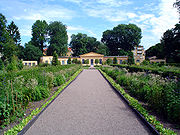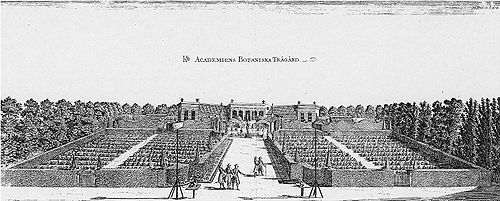
Linnaean Garden
Encyclopedia


Swedish language
Swedish is a North Germanic language, spoken by approximately 10 million people, predominantly in Sweden and parts of Finland, especially along its coast and on the Åland islands. It is largely mutually intelligible with Norwegian and Danish...
Linnéträdgården) is the oldest of the botanical garden
Botanical garden
A botanical garden The terms botanic and botanical, and garden or gardens are used more-or-less interchangeably, although the word botanic is generally reserved for the earlier, more traditional gardens. is a well-tended area displaying a wide range of plants labelled with their botanical names...
s belonging to Uppsala University
Uppsala University
Uppsala University is a research university in Uppsala, Sweden, and is the oldest university in Scandinavia, founded in 1477. It consistently ranks among the best universities in Northern Europe in international rankings and is generally considered one of the most prestigious institutions of...
in Sweden
Sweden
Sweden , officially the Kingdom of Sweden , is a Nordic country on the Scandinavian Peninsula in Northern Europe. Sweden borders with Norway and Finland and is connected to Denmark by a bridge-tunnel across the Öresund....
. It has been restored and is kept as an 18th century botanical garden, according to the specifications of Carolus Linnaeus
Carolus Linnaeus
Carl Linnaeus , also known after his ennoblement as , was a Swedish botanist, physician, and zoologist, who laid the foundations for the modern scheme of binomial nomenclature. He is known as the father of modern taxonomy, and is also considered one of the fathers of modern ecology...
.
The garden was originally planned and planted by Olaus Rudbeck
Olaus Rudbeck
Olaus Rudbeck was a Swedish scientist and writer, professor of medicine at Uppsala University and for several periods rector magnificus of the same university...
, professor of medicine, in 1655. Rudbeck also built the house adjacent to the garden. At the end of the 17th century it had about 1,800 different species, but was damaged in the Uppsala city fire 1702. Linnaeus became responsible for the garden in 1741 and had it rearranged according to his own ideas, documented in his work Hortus Upsaliensis (1748).

Uppsala Castle
Uppsala Castle is a 16th century royal castle in the historical city of Uppsala, Sweden. Throughout much of its early history, the castle played a major role in the history of Sweden....
had been donated to the university by King Gustav III
Gustav III of Sweden
Gustav III was King of Sweden from 1771 until his death. He was the eldest son of King Adolph Frederick and Queen Louise Ulrica of Sweden, she a sister of Frederick the Great of Prussia....
to serve as a new botanical garden, the old one was left to decay. It was bought by the Swedish Linnaean Society in 1917 and restored according to the detailed description in the Hortus Upsaliensis. The garden was later taken over by the university, while the Linnaean Museum in the house in which Linnaeus had his home is still run by the Society. It is now one of two satellite gardens of the larger University of Uppsala Botanic Garden near Uppsala Castle. The second satellite is Linnaeus Hammarby
Linnaeus Hammarby
Linnaeus Hammarby is one of three botanical gardens belonging to Uppsala University in Sweden. It was the former summer home of Carolus Linnaeus and his family.-See also:...
, the former summer home of Linnaeus and his family.

